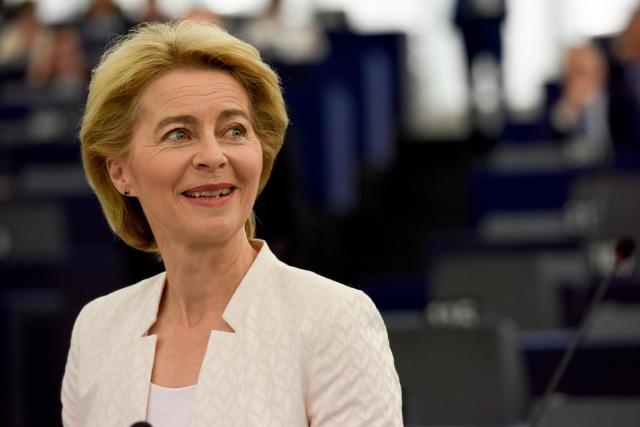
Imagining a geoeconomic European Union

In
Among the most visible effects to date of the return of Great Power competition has been an increase in trade regulation and state intervention in the economy that is evermore driven by geopolitical ambition and not strictly by market-oriented calculus. For the centres of economic power in Beijing and Washington, the economic infrastructure (institutions, rules, standards, relations) is becoming the primary venue for competition. By turning economic interdependence into political leverage, an age of geoeconomics has engulfed the international order.
This commentary was first published in Encompass-Europe. Read the full text below.
(Photo credit: The White House, Flickr)
*****
Imagining a geoeconomic European Union
Among the most visible effects to date of the return of Great Power competition has been an increase in trade regulation and state intervention in the economy that is evermore driven by geopolitical ambition and not strictly by market-oriented calculus. For the centres of economic power in Beijing and Washington, the economic infrastructure (institutions, rules, standards, relations) is becoming the primary venue for competition. By turning economic interdependence into political leverage, an age of geoeconomics has engulfed the international order.
To be fair, the EU has not been fully absent from geoeconomics. Its regulatory and market power shape technical standards adopted by companies globally, while its trade agreements externalise rules (e.g., environmental; labour) to third countries. These practices can, under circumstances, produce beneficial geopolitical value beyond easing business for companies. For example, data rules or industry and tech standards – which third countries and firms may adopt to gain access to the EU market – can support not only EU firms’ competitiveness but externalise EU values or even security interest.
The 2018 EU-Asia Connectivity Strategy – a comprehensive trade, investment, finance, development, infrastructure and foreign policy scheme – could also offers such strategic advantages. But unlocking the geoeconomic potential of connectivity requires not only cash (something the Strategy lacks), but also the definition of strategic objectives, political steer and engagement from all actors. Unfortunately, barely anyone even knows or speaks of this strategy beyond a Brussels clique. There is something to learn from the public diplomacy of China’s BRI.
Despite these partial success stories, Europe’s shrinking market (power) and growing challenges in the triangular relationship with the United States and China have complicated the world of geoeconomics. Today, Europe is not only asked to link specific commitments to its trade agreements or market access but understand and defend European interests at the intersection of economics, technology and security. A widening of the EU’s geoeconomic play is necessary if the Union is to remain an economic power broker able to secure Europe’s autonomy to make choices. A geoeconomic reorientation which is more assertive, more pragmatic, and more political is warranted.
The EU investment screening regulation and developments on 5G network security (with an EU report and toolbox) exemplify an EU policy reorientation which at least considers the vulnerabilities of economic and technological networks. But a more strategic approach which seeks to break down the barriers between economic and security concerns and which positions the EU in the deepening geoeconomic competition with the other powers remains wanting.
How can we imagine the EU becoming more geoeconomic?
First, the EU must set out how it wants to relate to the other powers; a strategy which allows the EU to engage one power without prompting the other to disengage, and vice versa. Push-back yes, but non-confrontational relations with the Great Powers should remain a baseline to an EU strategy. Developing a sub-strategy of European economic sovereignty, for instance as part of a new 2020 edition of the EU Global Strategy, could help link EU policies to Europe’s position between the other powers.
Second, the EU should strengthen its resilience to economic coercion from the other powers (trade, financial coercion). Inviting business to make more active use of the EU Trade Barriers Regulation could for instance offer the Commission more assertive power to enforce a level playing field when EU firms are unfairly treated – especially in combination with other ‘reciprocity instruments’ like the International Procurement Instrument. Meanwhile, the Iran nuclear deal episode demonstrated that evasion of US financial sanctions looks impractical in the short run. Only strengthening the role of the Euro as a geoeconomic instrument, by deepening structural, economic and monetary reforms, can be a viable long-term strategy to reduce the EU’s vulnerabilities from a weaponised dollar.
Third, a geoeconomic EU must retain its seat at the table of a new technology-security governance, i.e. emerging technologies and their regulation via export controls, supply-chain security, investment screening, and technical standards. Co-influencing evolving norms, laws and practices around emerging technologies with major strategic implications (e.g., AI; 5G; data governance) according to European interests and values will be of critical importance to European economic sovereignty (as the recent EU AI White Paper eludes to). Next to domestic action (e.g., EU supply chain security, export control regime, industrial policy considerations), this will require technology diplomacy with other powers. EU Member States and the Commission should seek to integrate existing diplomacy and regulatory streams with partners (e.g. United States, Japan) into multi-/plurilateral arrangements, such as expanding the scope of the US-EU-Japan Trilateral Group to discuss standards cooperation and technology regulation.
A consensus for a more geoeconomic EU is growing across Europe. To get it right, the EU needs a strategy which integrates external and internal policies, which balances opportunities and risks of interdependence and which relates action to global politics between the powers. On that basis, a geoeconomic EU in 2020 could see it fit to respond to growing challenges.